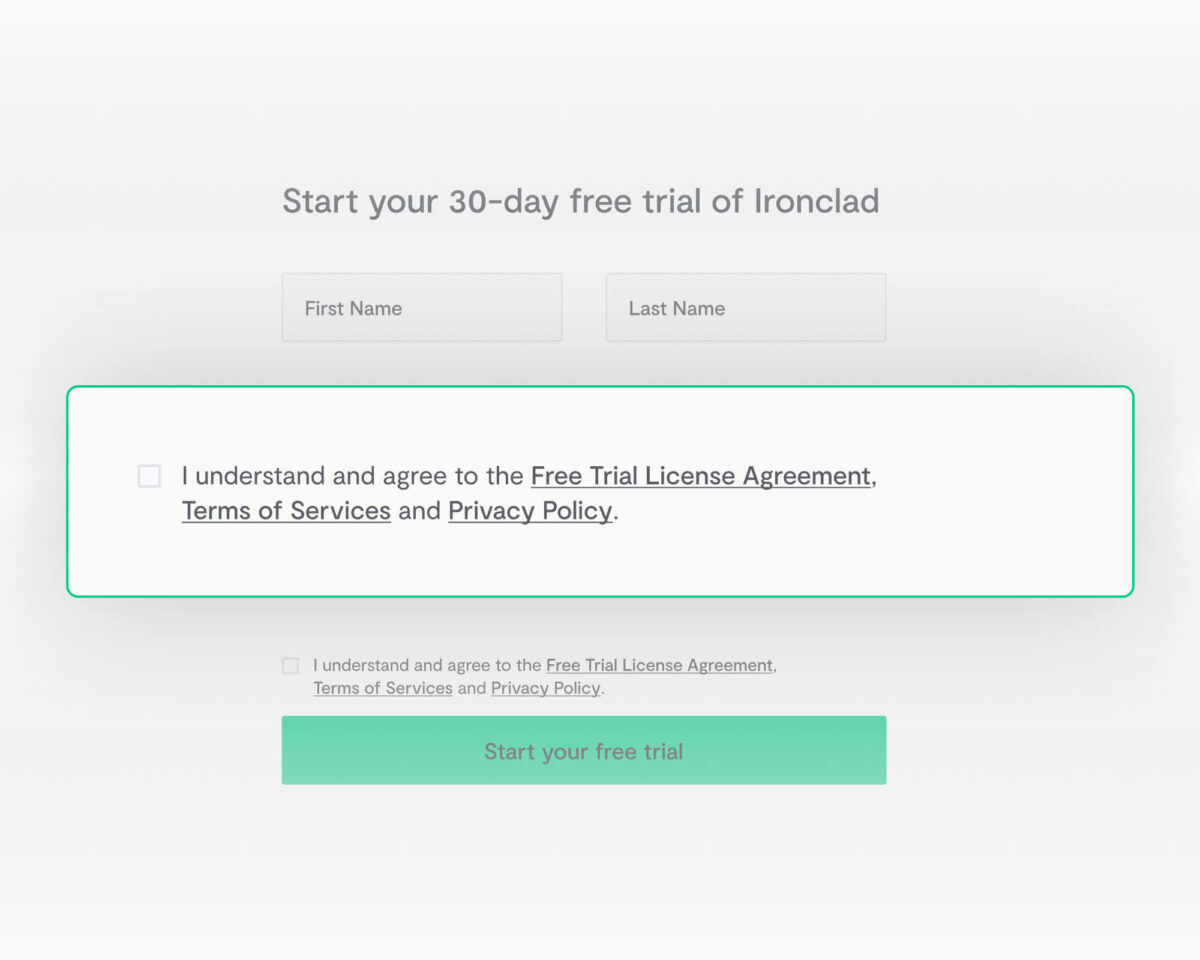Many companies use a type of contract called a terms and conditions agreement to outline the rules governing the interaction between its website and users. This is an important part of your website as it will ensure all parties know their obligations and rights, as well as the status of the relationship created when a user visits your website. To create an enforceable agreement, you’ll want to make sure you manage your contracts effectively and follow a few best practices.
Definition of Terms and Conditions
A website terms and conditions agreement informs your users of what to expect from your services or any other business you may conduct. A terms and conditions page is also known as terms of use and terms of service. There is no difference in definition; they all refer to the same type of agreement. The website terms and conditions will include a list of permitted and prohibited activities, the methods of termination of services, your contact information, etc.
Terms and conditions are not legally required. However, this legally binding agreement is vital to your operations. If a legal dispute arises between you and your users, the website terms and conditions agreement will govern that dispute and help protect you from liability.
Review the website terms and conditions agreements of other companies
Before you make your own online terms and conditions agreement, viewing those of your competitors or other companies in your industry may be beneficial. Seeing how they protect themselves and what clauses they choose to include may be helpful when you decide to craft your website terms and conditions. However, it’s important not copy other companies’ terms.
Related: Be Aware of These 5 Online Marketplace Risks
Tailor the website terms and conditions so that your business is represented in the best way. Because the agreement is legally binding, you should ensure that all clauses and wording are beneficial to your business and that the contract includes all the necessary clauses to protect you. If possible, have this agreement viewed by your legal team or legal counsel.
Remember, the terms of this agreement will depend on the nature of your business. You might want to include a section about delivery and warranties if you sell goods, while your services might include a description of any licensing you or your employees may need to perform those services. If you process the personal data of your consumers, you’ll need to comply with data privacy laws such as the California Consumer Privacy Act and the General Data Protection Regulation.
Elements of Website Terms and Conditions
The elements of a terms and conditions agreement will vary depending on your business and industry. When deciding what to include in your agreement, think about what’s most important for users to know about the goods or services you offer and your primary legal concerns.
Here are some common elements found in most website terms and conditions:
Website information
Your introduction paragraph should explain your company’s name, business type, and the goods and services you offer. You should include the names of any subsidiaries or partners that exist and participate in your business’s daily operations.
Permitted use statement
Like its title, the permitted use section outlines what users can do with your website. For example, it may explain the users’ rights to purchase your products. If you offer a service, this section will describe what kind.
Prohibited use statement
The prohibited use statement will describe the activities users are not permitted to do. Again, depending on your business, your prohibitions and restrictions will vary. Common restrictions include:
- Using the website for illegal purposes or harassing or threatening someone
- Infringing on the website’s copyright, trademark, and other intellectual property by copying, selling, or transferring any data about the website
- Using the website if the user does not meet the age requirement (if there is one)
- Using web services to violate the rights of other users
- Altering or modifying the website’s intellectual property
- Violating or breaching the website’s security and defense system
Indemnification and disclaimer of liability
This section is essential because it can help protect you from liability. You may be liable if a user uses your website illegally, and you’ll want the bad actor to indemnify you for any harm done.
Disruption of services
Service disruption is typical for any website. Maintenance and upgrades are part of enhancing your users’ experience. And sometimes errors happen, especially if your business is brand new and still ironing out all the details.
The website terms and conditions agreement should inform users of this possibility. You may want to notify your users before an update or warn them that disruptions could occur suddenly.
This section could include a promise to try to give prior notification of any disruption of service and resolve disruptions as soon as possible.
Length and termination of service
The website terms and conditions agreement should also explain the duration of the agreement. It begins once the user consents to the agreement and uses the services and ends when they cease to purchase goods from your website or use the services offered.
Privacy statement, cookie information, and confidentiality
You likely have a privacy policy for your website, and it’s common to include a link to your privacy statement in your website terms and conditions. You may also explain how your company uses cookies and include a link detailing how users can assent or withdraw their consent.
Another helpful clause could determine the status of the information provided by your web users. The information they give, like their address or email, may be confidential. If so, explain to them that you will not share it with anyone. If, on the other hand, this information is used or sold in any way to a third party, you should make that very clear to your web users and perhaps allow them to opt out.
Choice of law
Since the terms and conditions agreement is legally binding, you might want to include a choice of law clause to govern a dispute if it arises. Maybe you prefer arbitration or want the local laws of your business to govern. Or perhaps you are a national company and know that one state’s laws are more business-friendly than another and want to be subject to those laws.
Your legal department should review this option and decide on the best governing law for your business.
Agreeing to the terms and conditions
Remember, the online terms and conditions agreement is a legally binding document between you and your users. Users cannot modify the terms or cancel certain provisions of the agreement. You should explain to your users that by using your website, they are bound to all the clauses in the terms and conditions agreement.
Contact details
This last section should include your company’s contact details. This usually consists of the following information:
- Mailing address
- Email address
- Telephone number
If users have a dispute or question regarding the website terms and conditions, this section will give them the information they need to contact you.
Managing Your Website Terms and Conditions
Managing your online terms and conditions agreement is essential for effective enforcement. Many web users may not read through the agreement, but you should still craft the most effective agreement possible.
Contract lifecycle management software can help you craft and manage your terms and conditions agreement and save time when reviewing or editing all of your agreements. You’ll have one centralized location to store all of your contracts, and all parties will be able to revise and negotiate on one platform.
Your website terms and conditions agreement should be conspicuously displayed on your company’s site. It can be in your footer, linked in other policies, or on the main menu. It needs to be easy to find so that users can refer back to it when necessary.
While not required, you can also have your users physically assent to the terms and conditions of the contract to make the contract enforceable. This commonly involves a clickwrap solution, where users click a box assenting to the clauses in the website terms. This needs to be presented the first time the user visits your website before purchasing goods or using your services. You can make a clickwrap part of your online agreements via contract lifecycle management.
Create Your Own Website Terms and Conditions
Online terms and conditions are necessary so that all parties are aware of the rules that govern their actions. While specific clauses will vary depending on your business, each clause will provide an important foundation in your agreement.
The terms and conditions agreement is a legally binding contract, but users must see and read (or have the opportunity to read) it to agree to it. Make your website terms and conditions easy to understand, easy to find, and competently written.
Ironclad is not a law firm, and this post does not constitute or contain legal advice. To evaluate the accuracy, sufficiency, or reliability of the ideas and guidance reflected here, or the applicability of these materials to your business, you should consult with a licensed attorney. Use of and access to any of the resources contained within Ironclad’s site do not create an attorney-client relationship between the user and Ironclad.
- Definition of Terms and Conditions
- Elements of Website Terms and Conditions
- Managing Your Website Terms and Conditions
- Create Your Own Website Terms and Conditions
Want more content like this? Sign up for our monthly newsletter.



